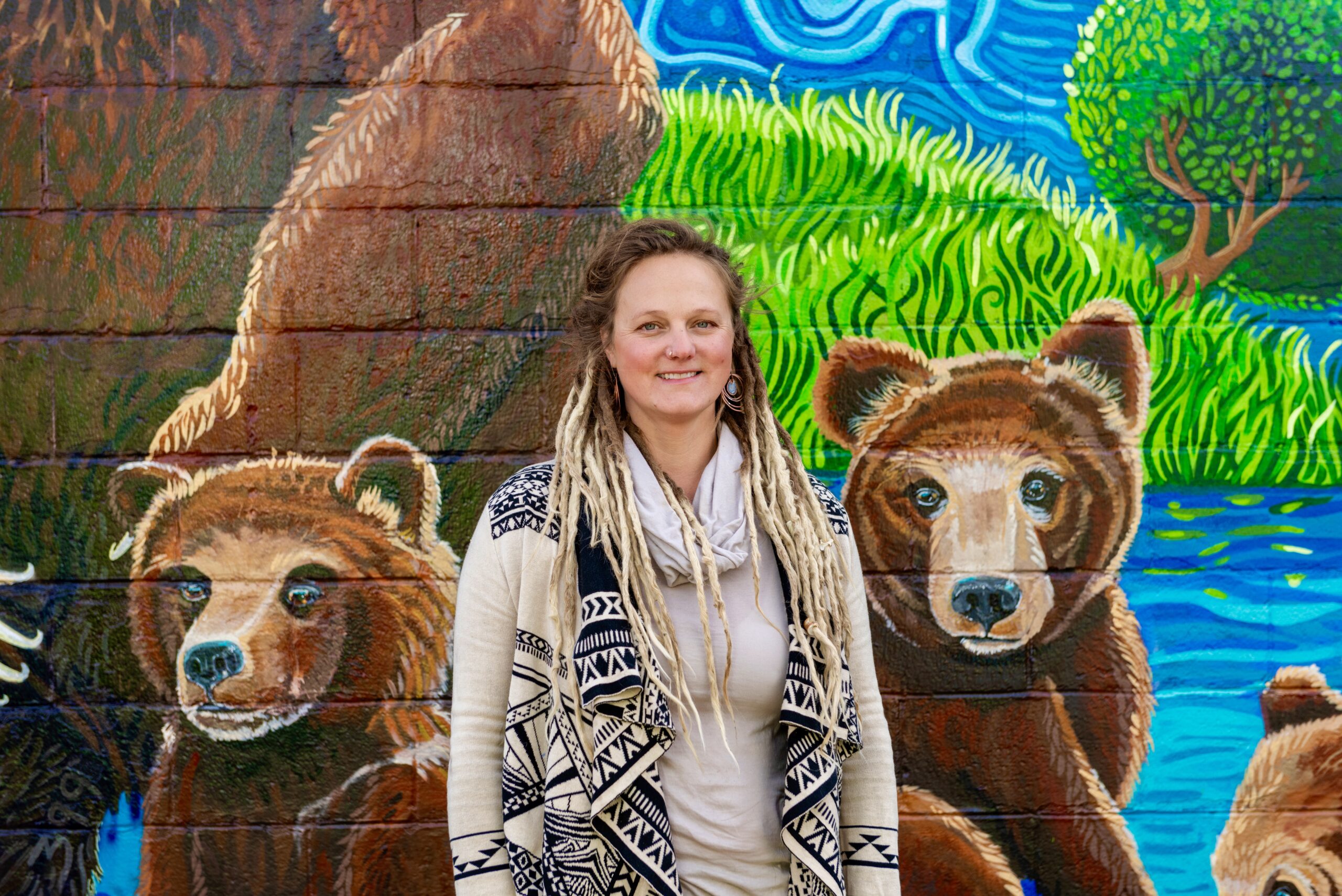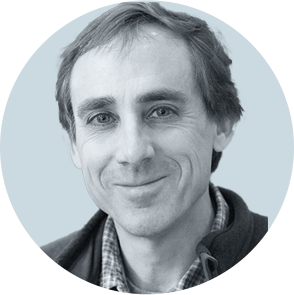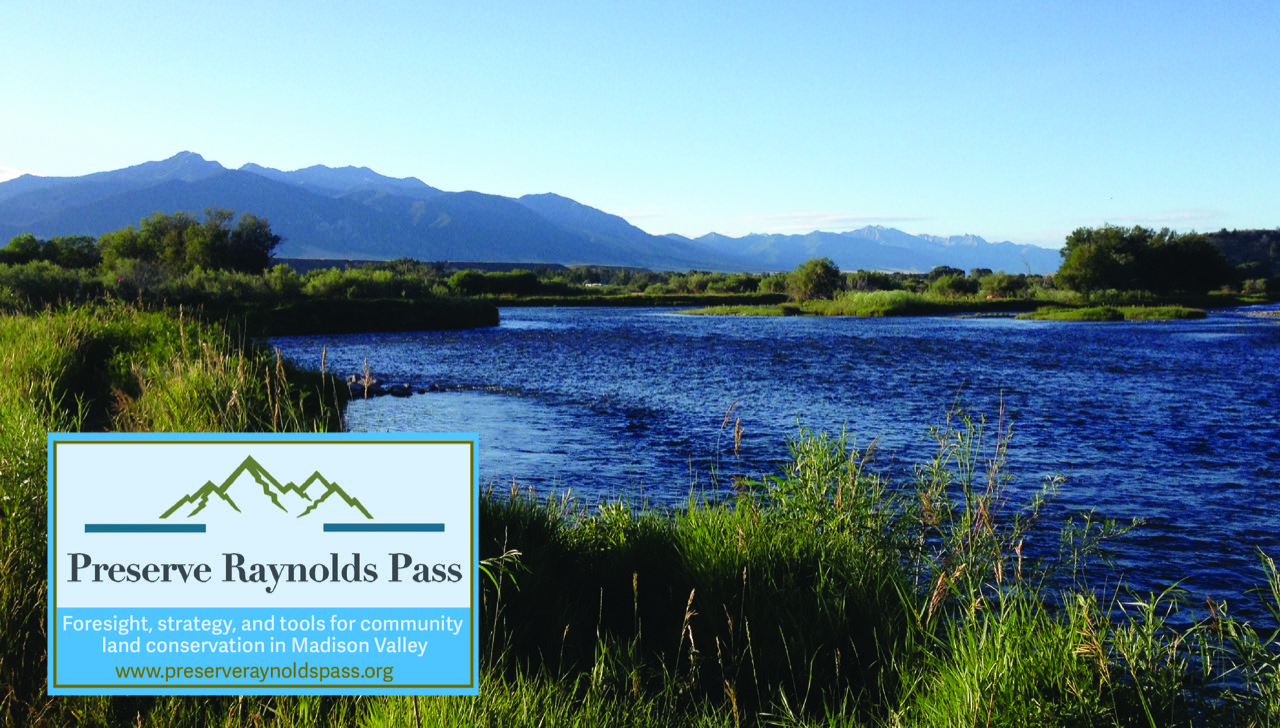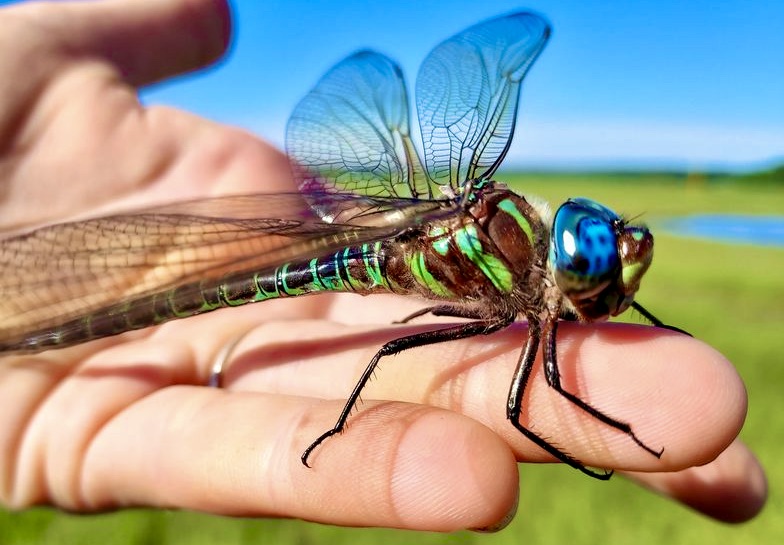By Todd Wilkinson
How and why did each of us get to this place?
The answer speaks not merely to us being here now as a community of avid readers concerned about the fate of the natural world. It invites us to reflect upon the physical pathways that each of us took to reach this moment of convergence. What stories can we share about the fateful hurdles of life put in our way, epiphanies had, obstacles overcome and loved ones lost in route?
In the Greater Yellowstone Ecosystem, there is a spectacular parallel involving a conjunction of non-human beings. This region’s assemblage of native wildlife diversity is an unrivaled remnant in the Lower 48. If members of each species were to share tales of their own journeys what would they tell us—and would we empathize?
Greater Yellowstone wildlife painter Helen Seay has produced an impactful visual storyboard that invites us to ponder the possibility. Her new artwork inhabits two walls located barely a stone’s throw away from Jackson’s famous elk antler archways adorning the Town Square. Rising as a pair of intra-facing outdoor murals, her multi-species creation, commissioned by the conservation organization, Wyoming Untrapped (WU), is meant to engender public appreciation for Greater Yellowstone’s stature as the cradle of American wildlife conservation.

Here, in the coming months, Yellowstonian will be providing narratives about the natural histories of Seay’s subjects that are intended to complement her engaging imagery. Commencing on January 1, 2025 and lasting for six months, our ongoing series of vignettes will culminate on the evening of Summer Solstice with a night of toasting real co-existence and a formal unveiling of Seay’s most ambitious artwork to date.
Seay is among a group of talented women globally who are leaving their mark with high profile public installations and street art. Readers can see more of Seay’s artwork by clicking here.
“Through Helen’s vision, WU wanted to tell the stories of individual sentient animals in Wyoming who often face hardships from the moment they are born just to survive another day. We tend to take their struggles for granted,” says longtime Jackson Hole conservationist and WU co-founder Lisa Robertson. “We want to inspire those who live in Wyoming to see the conservation of these animals as an important part of their heritage—and, along with the large number of visitors who come here each year, to have more appreciation for the value of sharing our landscape with these extraordinary wild neighbors. It is our hope that the mural sparks reflection—and respect, too—for the fact that wildlife needs freedom to roam.” Those words, “freedom to roam,” flow forth in Seay’s mural stream.
“Through Helen’s vision, WU wanted to tell the stories of individual sentient animals in Wyoming who often face hardships from the moment they are born just to survive another day. We tend to take their struggles for granted. It is our hope that the mural spark reflection—and respect, too—for the fact that wildlife needs freedom to roam.”
—Conservationist Lisa Robertson on the new mural in downtown Jackson, Wyoming completed by artist Helen Seay
Northwest Wyoming accounts for the largest percentage, by land mass, of Greater Yellowstone; it encompasses most of Yellowstone National Park and all of Grand Teton National Park. Jackson Hole is both a passageway for millions of people on their way to Yellowstone and it is also a destination. Similarly, it fulfills the same function for wildlife.
Greater Yellowstone has special distinction. It is a region where many species have been rescued from the brink of total extirpation. All its own, Jackson has been a living laboratory for scientists and conservationists where many ideas about preserving wild nature were pondered and then applied.
Seay’s mural is in some ways interactive. It invites viewers to see if they can identify all of the species depicted, from bison, wolves, grizzlies, and elk down to trumpeter swans, a sagebrush sparrow and boreal chorus frog.
“Public art can positively impact communities by serving as both a visual and educational resource,” says Karen Hanson, a nature photographer/videographer, conservationist, retired businesswoman and WU trustee. “These murals will offer residents and visitors to Jackson an opportunity to learn more about the diverse wildlife that calls this area home, fostering a deeper appreciation for the natural world around us.”
One of the reasons Robertson and Hanson felt an immediate kindredness with Yellowstonian, besides our in-depth reporting on wildlife issues, is that the founder of Artemis Institute (the non profit organization under which Yellowstonian operates as a special project) happens to be Dr. Lori Ryker. Ryker, an artist and alum of the Harvard Graduate School of Design, has long been a champion of public art and for a time Artemis Institute, which promotes a light on the land ethic with the human-built environment, was based in Jackson Hole. [In 2023, Artemis Institute brought noted LA street artist Eric Junker to Greater Yellowstone and he created a series of posters and mural concepts arrayed around bison, grizzlies and wolves].
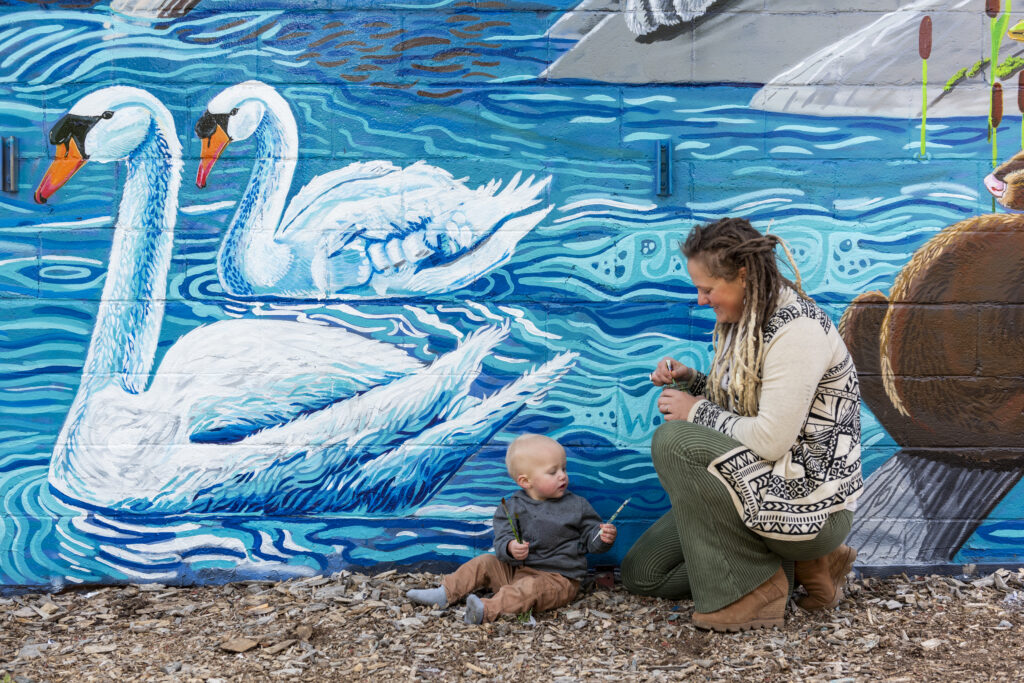
Whimsical and Pop arty, Seay’s animals fit into a noble tradition. For thousands of years, pictograph and petroglyph artisans on this continent have venerated wildlife. More recently, 150 years ago, paintings by Thomas Moran and black and white photographs by Moran’s traveling companion, William Henry Jackson, convinced Congress to set aside Yellowstone as the first national park of its kind in the world.
Today, Jackson Hole is arguably the capital of wildlife art, with the National Museum of Wildlife Art north of town being the only official Congressionally and presidentially designated national wildlife art museum in the country.
Seay’s art sensibilities possess an aesthetic and visual language that instantly resonates with young people. It gives visitors an introduction to the non-humans who reside in the natural panorama. The mural is located just off of South Glenwood Street. Robertson and Hansen said the mural couldn’t have happened without the approval of local Charlie Sands, founder of Sands Raft Company (now owned by Aramak) and owner of the Hatch Restaurant building and nearby building owner Nic Patrick of Cody, Wyoming lending two outside walls to serve as Seay’s “canvass.”
“My intention for this mural is to honor the vital connection between Wyoming’s majestic landscapes and the wildlife that depends on them. Wyoming is a tapestry of rugged mountains, sprawling plains, and pristine rivers that embody a deep sense of sacredness rooted in both natural beauty and ecological significance,” Seay told me. “These vast and untamed lands are home to a unique array of wildlife, from iconic species like grizzly bears, bison, and elk to lesser-known creatures like beavers and pine martens, that thrive in its diverse ecosystems. Without dedicated conservation efforts, the spirit of this wild and sacred place risks being lost forever. It is my hope to celebrate the animals I painted on the wall and more importantly the wild ones living off the wall, to give them a voice in raising awareness and passion around conserving their lives and their land.”
“Without dedicated conservation efforts, the spirit of this wild and sacred place risks being lost forever. It is my hope to celebrate the animals I painted on the wall and more importantly the wild ones living off the wall, to give them a voice in raising awareness and passion around conserving their lives and their land.”
—Wildlife artist Helen Seay on inspiration for her mural
Originally from a northern suburb of Atlanta, Seay went to the University of Georgia in Athens and sought a degree in graphic design. A boyfriend at the time was an avid hiker and took her on explorations in the southern Appalachians. Together, they came West on a vacation to Glacier National Park and lived for a summer near that nature preserve which straddles the US border with Canada and the Blackfeet Indian Reservation.
“I knew it was all over for me [her search to find a place that spoke to heart and spirit],” she said. “I knew I didn’t belong in the East.”
The day Seay graduated from college, she packed up her dog and belongings and headed to the Northern Rockies, living in Whitefish, Montana for a winter and learning to ski. The following year, she worked at Grand Targhee and remained in Greater Yellowstone, always living on the west side of the Tetons.
For a span of years, Seay worked odd jobs. Seay had done some art shows and created hats, t-shirts and greeting cards. Then, in 2018, a representative of Friends of the Teton River, based in Driggs, reached out with a novel assignment: applying her talent to enliven unsightly vaulted toilets at a number of landings. Needless to say, river users loved them. Over the course of six years, she completed eight comissions and the work enabled her to become a full-time artist. Seay later was commissioned to produce a mural for Grand Teton National Park Foundation located in an alleyway behind Shirt Off My Back just off Cache.
The meeting between Robertson and Seay was, in the opinion of both, pure serendipity. During that stretch of time, Lisa acquired one of her works and she kept thinking of enlisting Seay to do a conservation-related mural because the two women share the same values when it comes to wildlife.
Robertson has been a vocal champion for beavers and their ecological role as keystone habitat creators and holding water in the landscape as a way of buffering the effects of climate change.
Interestingly, each year the non profit organization, Jackson Hole Public Art, underwrites projects aimed at advancing public education. One of its initiatives is called WildWalls which enlists artists to create wheat paste murals through town every summer and the medium enables them to be removed every autumn.

Local non-governmental groups can request a particular theme and artists who sign up can choose which project they are interested in. Seay signed up to create a beaver mural at the encouragement of WU. Seeing the impact, Robertson returned to Seay again and said, “Now we would like you to paint a full-scale lasting mural that engages people.”
Seay began working on it during the summer of 2024 and she put the finishing touches on it in autumn, the day news arrived that Jackson Hole Grizzly 399 had been tragically killed in a collision with motorist south of the valley. By design, Seay had given 399 a poignant place in her composition—as the shining symbol of how humans relate to not only individual species, but individual animals that become representatives of those species.
On one of two panels that rises 14 feet tall and measures 32 feet long, 399 and a group of cubs are featured along with other wildlife. A suite of other Greater Yellowstone species greet viewers on an adjacent wall. Strolling into the creative space is enchanting. As Seay’s vision started to take shape, passersby would gather. They took selfies of themselves with Seay and the animals. The painter says most satisfying to her was the level of interest and comments that came from children. For Seay, the experience was deeply personal. On many days her 18-month-old son, Caelen, was nearby, playing on a blanket, watching his mother bringing the scenes to life.
“Helen is such a good soul and you can feel it in her work. I am a big fan of the masterpieces in the National Museum of Wildlife Art,” Robertson said. “What Helen has created is something contemporary and additive to the foundation of wildlife art that is already present.”
I’ve been writing about wildlife art for three and a half decades. What I love about art is that it unites us around things we value and can spark conversations. Wildlife is not only a proud bonding ingredient in our shared identify, but the range of species that exists in Jackson Hole, inside the south-central realm of the Greater Yellowstone Ecosystem, is truly a miracle in this, the third full decade of the 21st century.
Look for the vignettes to begin appearing here on January 1 and on a special webpage created by Wyoming Untrapped titled Wild Journeys. Many of the stories of perseverance will surprise you.
Photos below: Wyoming Untrapped co-founder Lisa Robertson stands with a pack of Seay’s wolves and WU trustee Karen Hanson and dog, Riley, mingle among the offspring of Grizzly 399 and a variety of other wild GYE denizens. Photo of Hanson courtesy Lisa Robertson; photo of Robertson by David Bowers.
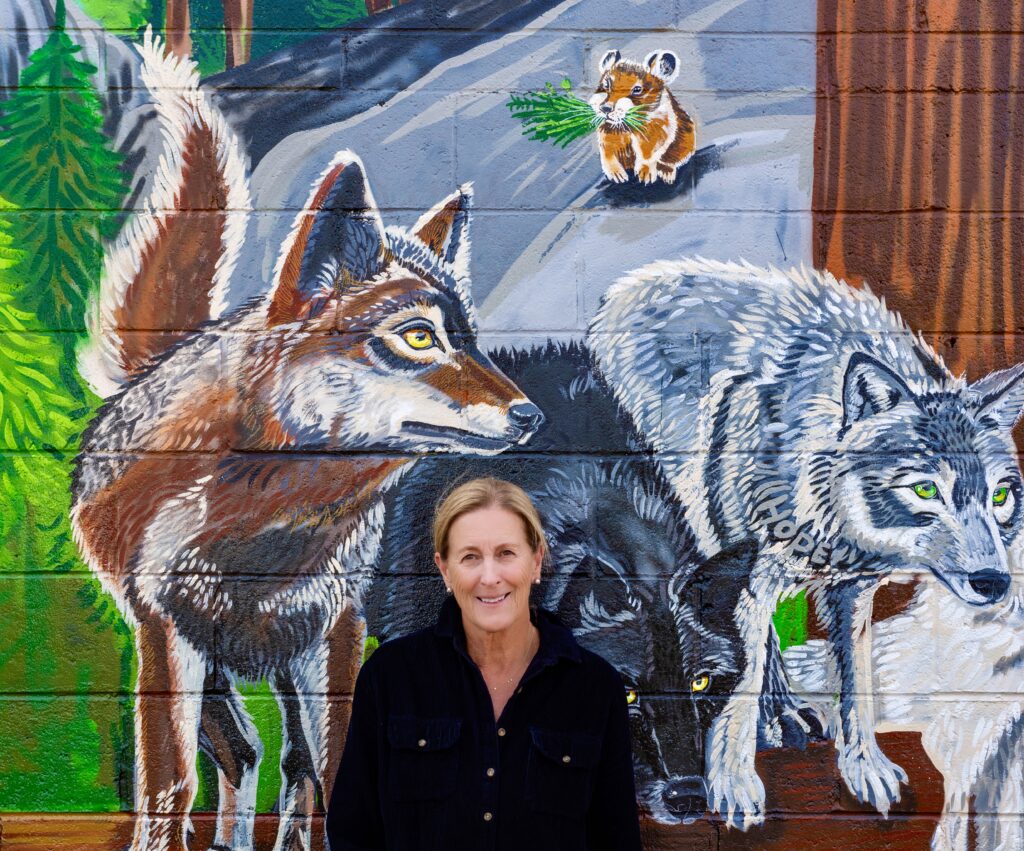
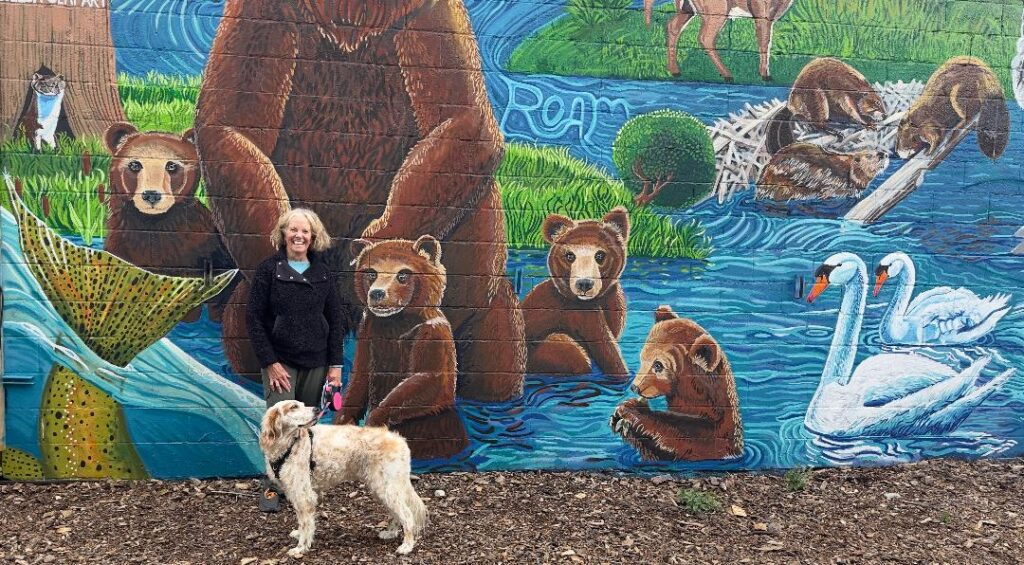
READ THE STORIES IN OUR ONGOING SERIES:

